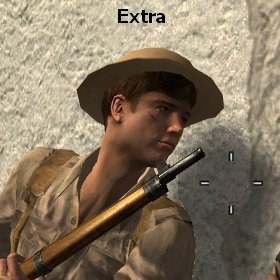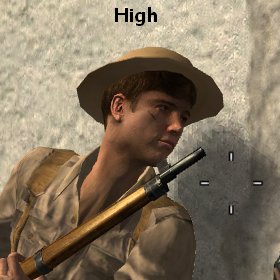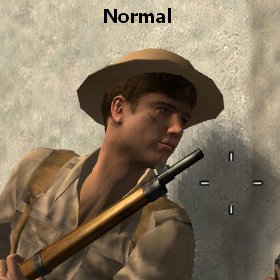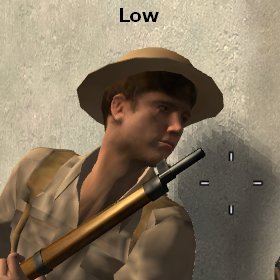 |
||
|
||
| ||
Version 1.2, 29.02.2008
Video memory sizeGPU is not the only factor affecting graphics card performance. Any processor needs a large volume of dedicated memory with high bandwidth for writing and reading textures, vertices, buffer data, etc. Even a powerful GPU can be bottlenecked by slow and insufficient video memory, therefore the latter (as well as external memory controllers) is very important. Memory chips are usually located on a card around a GPU. Some products already contain 12 memory chips. In some cases there is no even passive cooling for them. But the most popular solution is a common cooler, and sometimes memory heat sinks. That's how memory chips look like in GeForce 8800 GTS with its cooling system removed:  Modern graphics cards have memory ranging from 128 MB to 1024 MB. Low-End and Mid-End products usually have 256 MB of memory. High-End come with 512 MB and more (with some exceptions). The more memory is installed on a graphics card, the more data (textures, vertices, and buffers) it can store, so there is no need to use slower access to PC RAM. Textures occupy lion's share of memory. Let's examine screenshots taken in Call of Duty 2 with different texture quality settings: 
 
 Call of Duty 2 adjusts texture quality automatically based on memory available to textures (video memory minus frame buffer). For example, the Extra mode is enabled automatically for graphics cards with 320-512 MB; High or Normal - for 256 MB cards, depending on resolutions and AA levels; Low - for 128 MB. Even if you manually set maximum quality, a graphics card with insufficient memory will have to use some PC RAM, which will significantly reduce performance and gameplay comfort. Below is the table with average video memory usage for some modern 3D games at maximum quality settings, 1024x768, AA 4x (where possible). Information is taken from technological game reviews and other articles.
As you can see, all modern games have high video memory requirements. There are already no games, which can run well with just 128 MB. They use up to 500-600 MB. It does not mean that all game resources should be uploaded to video memory of a graphics card. Games often let the API manage resources, especially as Direct3D 10 uses video memory virtualization. Nevertheless, there is an apparent tendency to increase requirements to video memory size on graphics cards. Judging by this table, the minimum video memory size is 256-320 MB, 128 MB will be insufficient. But the optimal value is 512 MB now. Especially as memory requirements will change in higher resolutions and future games, so you should choose a graphics card that has some memory reserve for the future. On the other hand, you will hardly need more than 1 GB of video memory in the nearest future. Sometimes memory size published on a product box does not match the total size of installed chips. It used to happen with Low-End graphics cards that worked with a part of system memory, employing NVIDIA TurboCache or ATI HyperMemory technologies: For marketing reasons, specifications of such graphics cards mentioned total amount of memory, including shared RAM (e.g., 128 MB) instead of physical 16-32 MB. You should be careful about that and read our reviews not to be cheated in future. But actually you don't have to worry, because such products are obsolete now, being pressed away by integrated chipsets. Now that we've sorted out video memory sizes, we have to remember that it's not only size that matters. Inexpensive graphics cards are sometimes equipped with more memory for the sake of impressive specifications (and better sales). However in a Low-End graphics card such memory size makes no sense, because it still cannot provide acceptable framerate at texture- and geometry-intensive settings. Salespersons sometimes boast about memory size like it's the main graphics card feature. This often confuses inexperienced users unfamiliar with the real state of things. Let's compare performance of cards with different memory sizes on the example of two similar NVIDIA GeForce 8800 GTS solutions that differ only in terms of video memory size. The first card has 320 MB of memory, and the second card has 640 MB. Any shop assistant will tell you that the second graphics card is much faster, except for situations when the store has only 320 MB products in stock (we do not take into account those rare honest and competent shop assistants). But is that true? Let's find out:
As you can see, video memory size has little effect on performance in most modes. Performance drops only at very high resolutions and maximum quality settings, when a 320 MB card is noticeably outperformed by its more expensive modification. On the whole, we can say that video memory size does not affect performance that much, so you shouldn't compare products by this feature only. NOTE! We speak of memory sizes above 256 MB! In this case, memory volume rarely affects performance. But if we compare a 128 MB card and a 256 MB card, the conclusions would be different. You see, game developers try to fit game resources into video memory of popular cards. Today it's 256 MB. Although the new standard is 320-512 MB. A smaller amount of memory in your graphics card would cause modern games to either run slowly (because of PC RAM usage), or prevent you from playing at maximum quality, or both. Game developers are constantly increasing the estimated video memory size. While several years ago a graphics card could do well with 128 MB of memory, today there are projects requiring over 256 MB. They are few, but they exist (see the table above). So if a couple of graphics cards differ in memory sizes (being identical in clock rate and bus width) and are priced similarly, you should buy the one that has more memory. However, do not "chase numbers" - remember that no Low-End product can benefit from 512 MB of memory. Same with 1GB - this memory volume is currently excessive. Thus we can state that today 256-320 MB is optimal for Low-End and Lower Mid-End cards; and 512-768 MB is currently optimal for Upper Mid-End and High-End products. Larger volumes are used rarely now. Memory bandwidth in more detailAnother important feature we have already mentioned is memory bandwidth. It depends on memory clock rate and memory bus width. This feature determines the amount of data, which can theoretically be transferred to/from memory per unit time. In other words, it is speed at which a graphics core can write and read data to/from video memory. So, the faster a card reads texture and geometry data and writes computed pixels, the higher performance is. Peak memory bandwidth can be easily calculated - it's a product of effective memory clock rate and the amount of data transferred per cycle (memory bus width). For example, memory bandwidth of GeForce 8800 GTS that has a 320-bit bus and memory clock rate of 800(1600) MHz would be: So, when you choose between graphics cards with different memory sizes, you should always pay attention to clock rates, bus width, and prices! For example, if there are two Low-End cards - with 256 MB and 512 MB memory - and the latter is much more expensive, there is no point in buying the 512 MB product, because such a Low-End graphics card will not gain much performance from this amount of memory. Another example is graphics cards with different memory sizes and clock rates. In this situation your choice will depend on the graphics card level and clock rate difference. And you shouldn't forget about prices, of course. For example, if you must choose between a 320 MB overclocked High-End solution and a similar, but more expensive 640 MB card with reference clock rates, the former product would be more expedient at the moment, because it would provide higher performance nearly in all modes except for the highest resolutions. Here is the proof: Have a look at that article charts - overclocked graphics cards outperform the reference-clocked graphics card with more memory in most modes. The doubled memory size affects performance only at the highest resolutions. Of course, you should also consider the growing requirements of games to video memory. The situation may change to the opposite in a year. Next: GPUs, models, and vendors Write a comment below. No registration needed!
|
Platform · Video · Multimedia · Mobile · Other || About us & Privacy policy · Twitter · Facebook Copyright © Byrds Research & Publishing, Ltd., 1997–2011. All rights reserved. |